key battery BMW X5 2005 E53 Central Body Electronics Workshop Manual
[x] Cancel search | Manufacturer: BMW, Model Year: 2005, Model line: X5, Model: BMW X5 2005 E53Pages: 64, PDF Size: 4.03 MB
Page 24 of 64
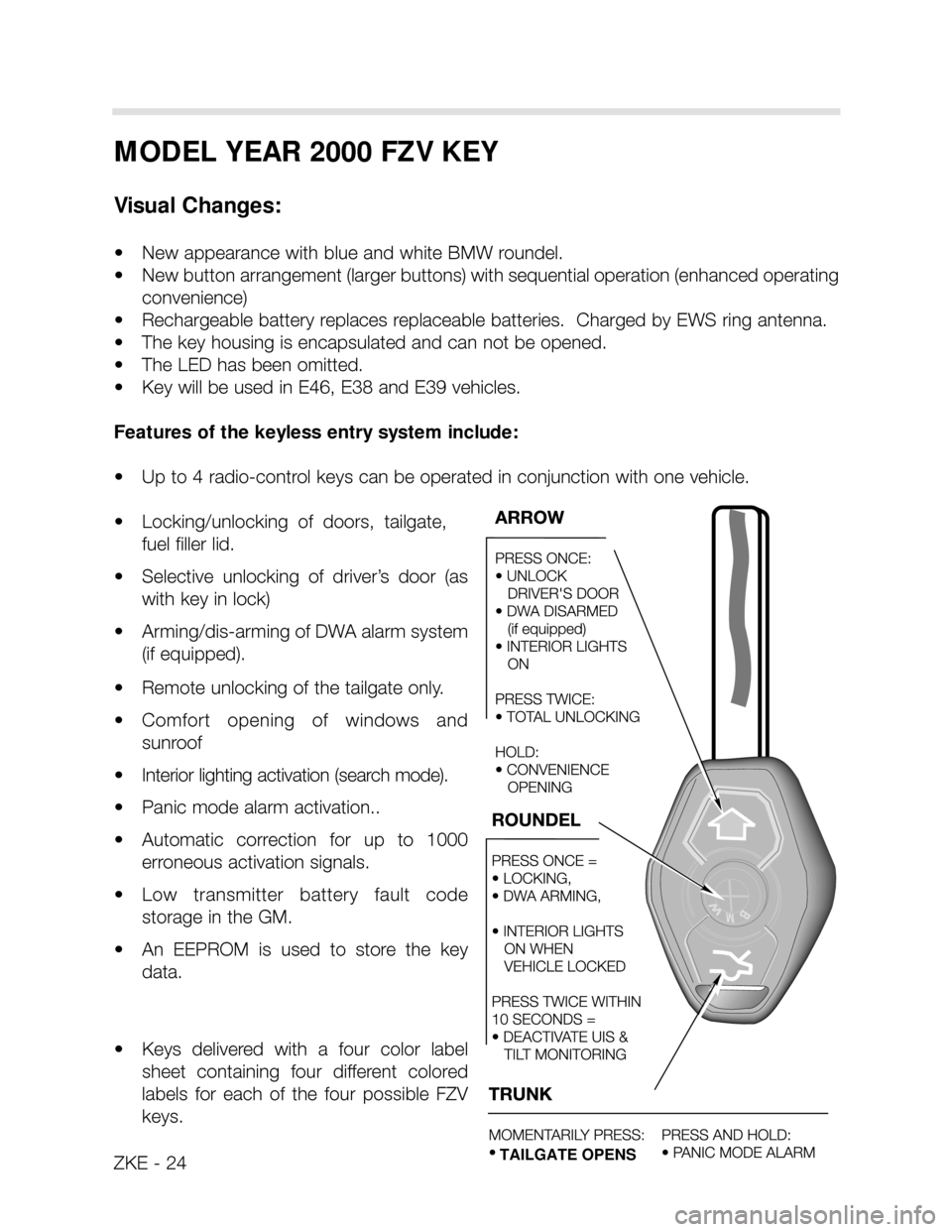
MODEL YEAR 2000 FZV KEY
Visual Changes:
• New appearance with blue and white BMW roundel.
• New button arrangement (larger buttons) with sequential operation (enhanced operating
convenience)
• Rechargeable battery replaces replaceable batteries. Charged by EWS ring antenna.
• The key housing is encapsulated and can not be opened.
• The LED has been omitted.
• Key will be used in E46, E38 and E39 vehicles.
Features of the keyless entry system include:
• Up to 4 radio-control keys can be operated in conjunction with one vehicle.
• Locking/unlocking of doors, tailgate,
fuel filler lid.
• Selective unlocking of driver’s door (as
with key in lock)
• Arming/dis-arming of DWA alarm system
(if equipped).
• Remote unlocking of the tailgate only.
• Comfort opening of windows and
sunroof
• Interior lighting activation (search mode).
• Panic mode alarm activation..
• Automatic correction for up to 1000
erroneous activation signals.
• Low transmitter battery fault code
storage in the GM.
• An EEPROM is used to store the key
data.
• Keys delivered with a four color label
sheet containing four different colored
labels for each of the four possible FZV
keys.
ZKE - 24TAILGATE OPENS
Page 26 of 64
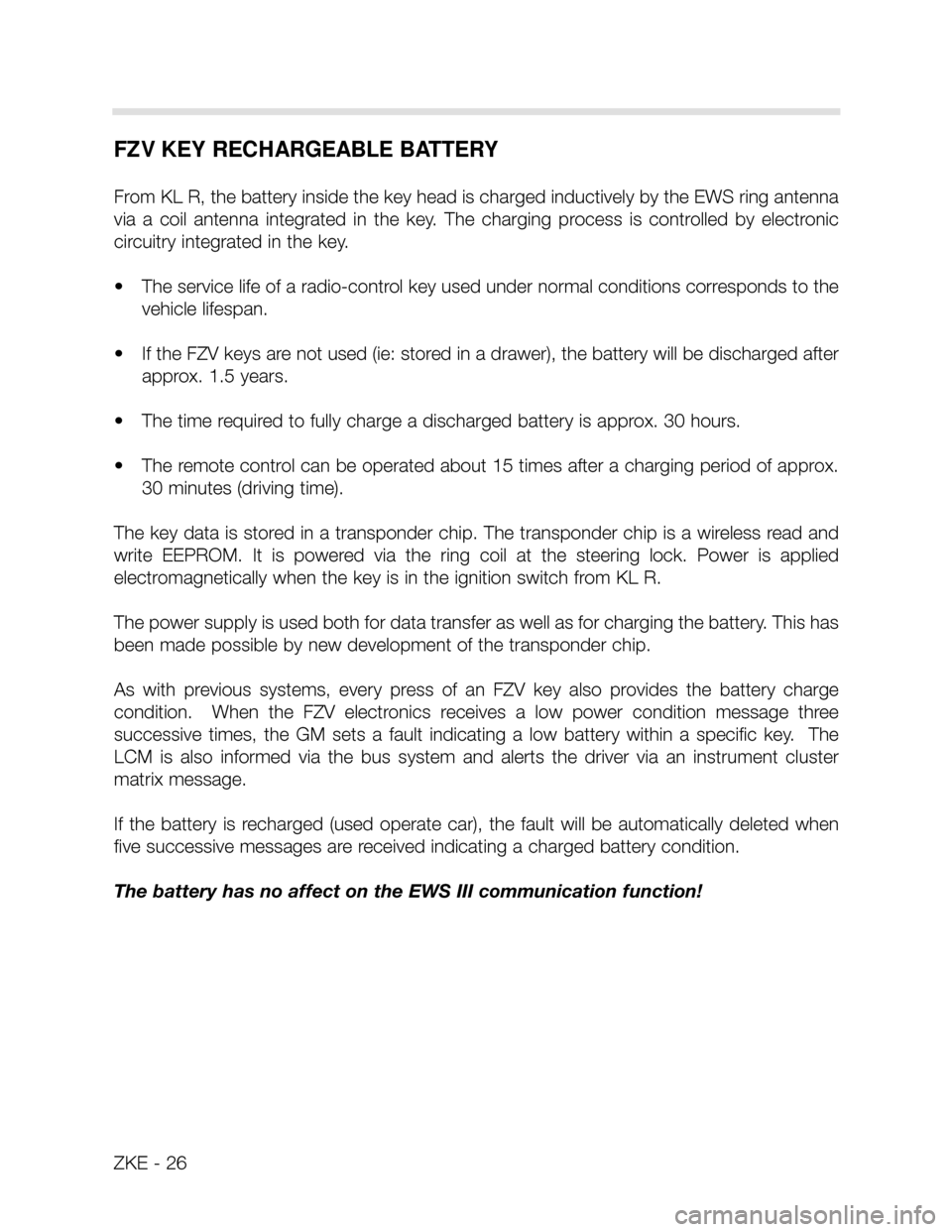
FZV KEY RECHARGEABLE BATTERY
From KL R, the battery inside the key head is charged inductively by the EWS ring antenna
via a coil antenna integrated in the key. The charging process is controlled by electronic
circuitry integrated in the key.
• The service life of a radio-control key used under normal conditions corresponds to the
vehicle lifespan.
• If the FZV keys are not used (ie: stored in a drawer), the battery will be discharged after
approx. 1.5 years.
• The time required to fully charge a discharged battery is approx. 30 hours.
• The remote control can be operated about 15 times after a charging period of approx.
30 minutes (driving time).
The key data is stored in a transponder chip. The transponder chip is a wireless read and
write EEPROM. It is powered via the ring coil at the steering lock. Power is applied
electromagnetically when the key is in the ignition switch from KL R.
The power supply is used both for data transfer as well as for charging the battery. This has
been made possible by new development of the transponder chip.
As with previous systems, every press of an FZV key also provides the battery charge
condition. When the FZV electronics receives a low power condition message three
successive times, the GM sets a fault indicating a low battery within a specific key. The
LCM is also informed via the bus system and alerts the driver via an instrument cluster
matrix message.
If the battery is recharged (used operate car), the fault will be automatically deleted when
five successive messages are received indicating a charged battery condition.
The battery has no affect on the EWS III communication function!
ZKE - 26
Page 30 of 64
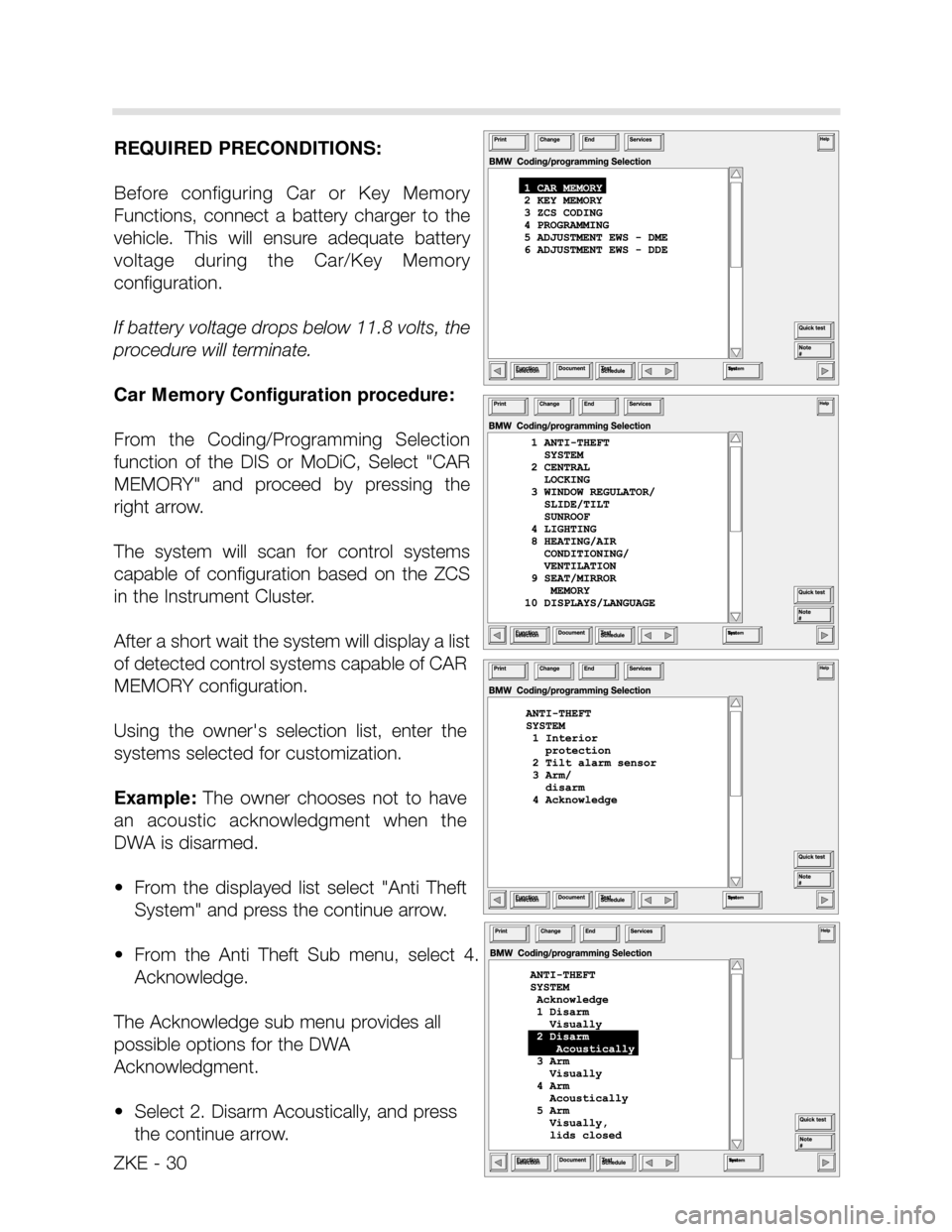
ZKE - 30
REQUIRED PRECONDITIONS:
Before configuring Car or Key Memory
Functions, connect a battery charger to the
vehicle. This will ensure adequate battery
voltage during the Car/Key Memory
configuration.
If battery voltage drops below 11.8 volts, the
procedure will terminate.
Car Memory Configuration procedure:
From the Coding/Programming Selection
function of the DIS or MoDiC, Select "CAR
MEMORY" and proceed by pressing the
right arrow.
The system will scan for control systems
capable of configuration based on the ZCS
in the Instrument Cluster.
After a short wait the system will display a list
of detected control systems capable of CAR
MEMORY configuration.
Using the owner's selection list, enter the
systems selected for customization.
Example:The owner chooses not to have
an acoustic acknowledgment when the
DWA is disarmed.
• From the displayed list select "Anti Theft
System" and press the continue arrow.
• From the Anti Theft Sub menu, select 4.
Acknowledge.
The Acknowledge sub menu provides all
possible options for the DWA
Acknowledgment.
• Select 2. Disarm Acoustically, and press
the continue arrow.
Page 34 of 64
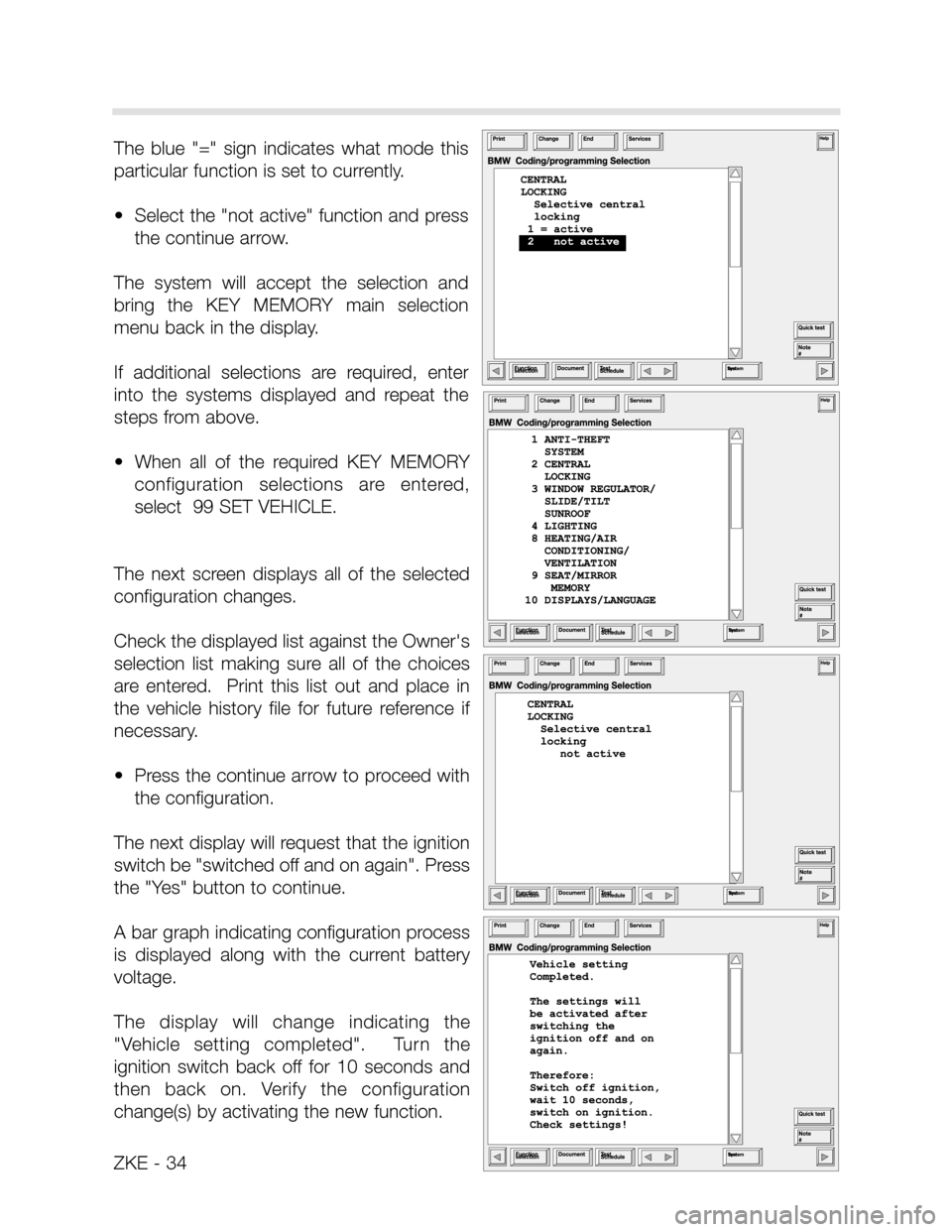
ZKE - 34
The blue "=" sign indicates what mode this
particular function is set to currently.
• Select the "not active" function and press
the continue arrow.
The system will accept the selection and
bring the KEY MEMORY main selection
menu back in the display.
If additional selections are required, enter
into the systems displayed and repeat the
steps from above.
• When all of the required KEY MEMORY
configuration selections are entered,
select 99 SET VEHICLE.
The next screen displays all of the selected
configuration changes.
Check the displayed list against the Owner's
selection list making sure all of the choices
are entered. Print this list out and place in
the vehicle history file for future reference if
necessary.
• Press the continue arrow to proceed with
the configuration.
The next display will request that the ignition
switch be "switched off and on again". Press
the "Yes" button to continue.
A bar graph indicating configuration process
is displayed along with the current battery
voltage.
The display will change indicating the
"Vehicle setting completed". Turn the
ignition switch back off for 10 seconds and
then back on. Verify the configuration
change(s) by activating the new function.
Page 62 of 64
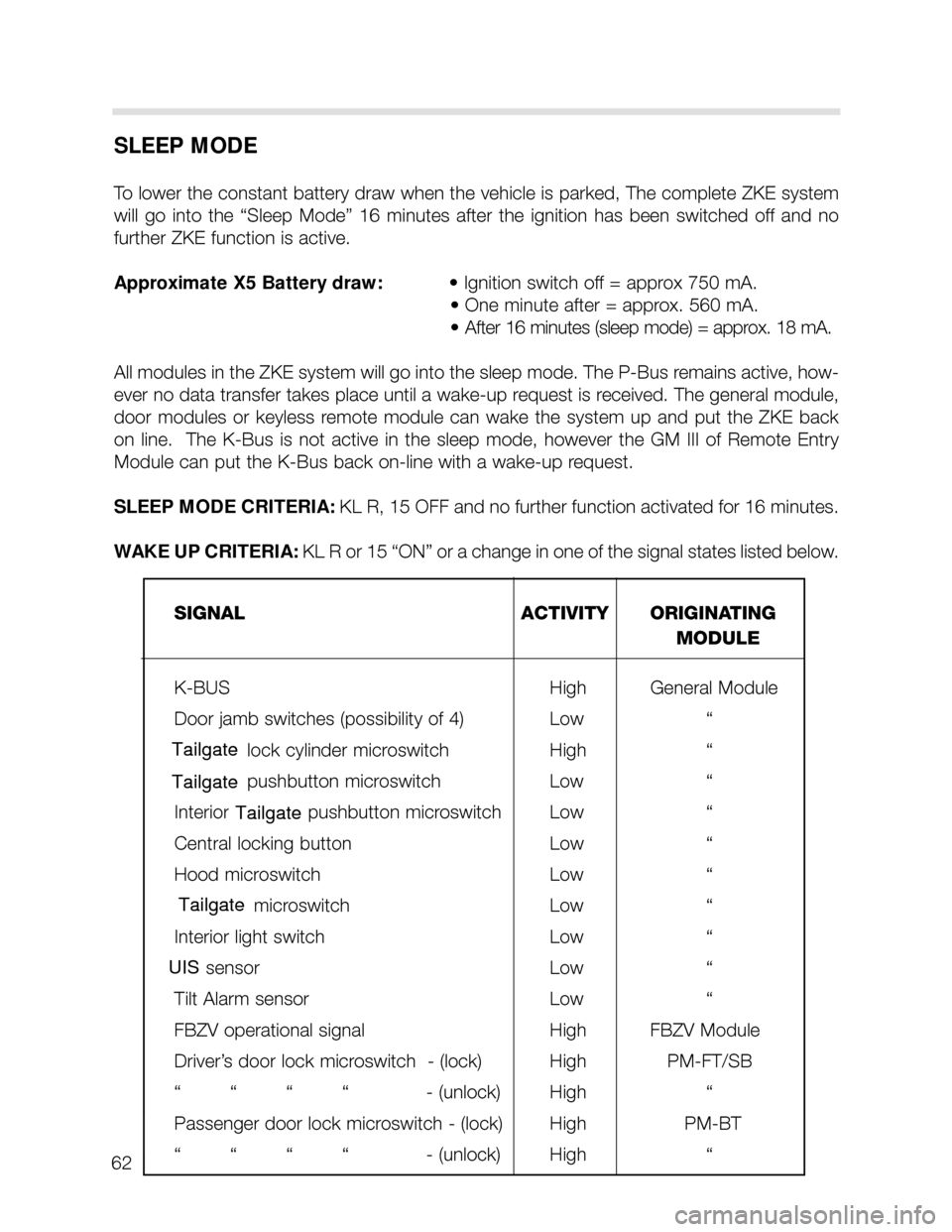
62
SLEEP MODE
To lower the constant battery draw when the vehicle is parked, The complete ZKE system
will go into the “Sleep Mode” 16 minutes after the ignition has been switched off and no
further ZKE function is active.
Approximate X5 Battery draw: • Ignition switch off = approx 750 mA.
• One minute after = approx. 560 mA.
• After 16 minutes (sleep mode) = approx. 18 mA.
All modules in the ZKE system will go into the sleep mode. The P-Bus remains active, how-
ever no data transfer takes place until a wake-up request is received. The general module,
door modules or keyless remote module can wake the system up and put the ZKE back
on line. The K-Bus is not active in the sleep mode, however the GM III of Remote Entry
Module can put the K-Bus back on-line with a wake-up request.
SLEEP MODE CRITERIA: KL R, 15 OFF and no further function activated for 16 minutes.
WAKE UP CRITERIA: KL R or 15 “ON” or a change in one of the signal states listed below.
SIGNAL ACTIVITY ORIGINATING
MODULE
K-BUS High General Module
Door jamb switches (possibility of 4) Low “
Trunk lid lock cylinder microswitch High “
Trunk lid pushbutton microswitch Low “
Interior Trunk lid pushbutton microswitch Low “
Central locking button Low “
Hood microswitch Low “
Trunk Lid microswitch Low “
Interior light switch Low “
FIS sensor Low “
Tilt Alarm sensor Low “
FBZV operational signal High FBZV Module
Driver’s door lock microswitch - (lock) High PM-FT/SB
““““ - (unlock) High “
Passenger door lock microswitch - (lock) High PM-BT
““““ - (unlock) High “
Tailgate
Tailgate
Tailgate
Tailgate
UIS